Your Ultimate Guide to Choosing Kite Surfing Kites
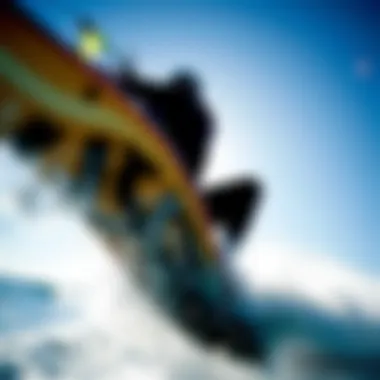
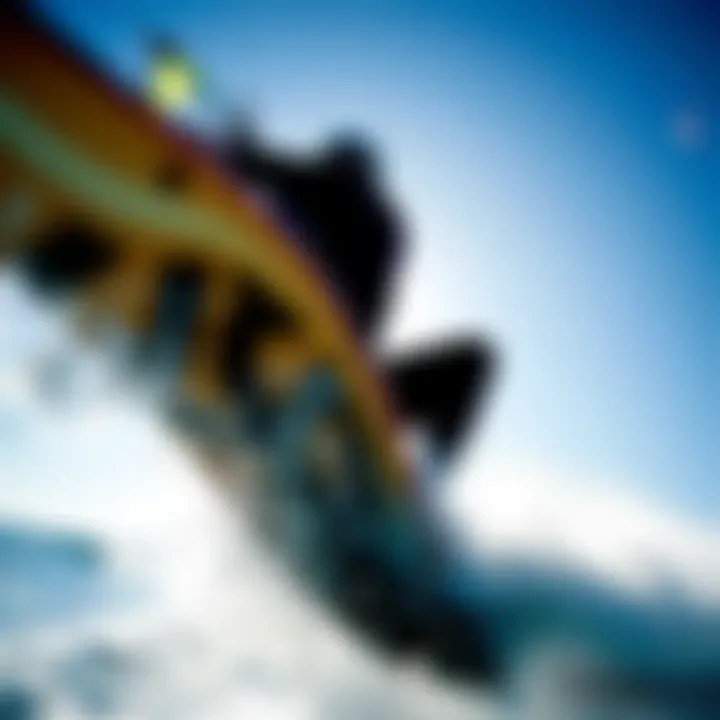
Intro
Kite surfing is not merely a pastime; it’s a blend of skill and passion that opens up a world of exhilarating experiences. Choosing the right kite as you step into the waves can either make or break your surfing journey. When navigating the kite surfing market, the array of options can feel overwhelming. This article aims to break down the essential elements one needs to consider while buying kite surfing gear, particularly focusing on kites available for sale.
Understanding the type of kite suited for your style, checking the seller's credibility, and knowing how to maintain your gear effectively are all critical aspects that will be discussed. With insights tailored for both novice and experienced kite surfers, you’ll find ways to align your gear choices with your unique aspirations. Now, let’s stitch together the fabric of kite surfing equipment, starting with the crucial insights into the gear itself.
Equipment Insights
When it comes to kite surfing, having the right equipment is like getting the engine of a car right. You wouldn't drive a car without knowing what it needs to run smoothly, and similarly, you should be well-versed in kite specifications and seller reliability before investing.
Latest Gear Reviews
Kites vary widely in design and functionality. Each kite serves different conditions and riding styles, so understanding their nuances is essential. Here’s a snapshot of some top-rated kites you might find in the market:
- North Reach: Known for its versatility, this kite is well-loved for both jumping and wave riding. It holds its position in strong winds, making it reliable for various conditions.
- Ozone Edge: Tailored for speed and performance, the Edge remains a favorite among seasoned kite surfers who thrive on advanced maneuvers. Its structure allows excellent stability in turbulent conditions.
- Cabrinha Switchblade: This kite stands out for its ease of use and consistent performance, ideal for beginners. It allows for better control when learning the ropes of kite surfing.
Seeing that gear reviews are often subjective, consider engaging with fellow kite surfers on forums like Reddit or checking Facebook groups specializing in kite surfing. These platforms provide insights from everyday users, as honest reviews often shine a light on aspects that manufacturers may not emphasize.
Essential Gear Maintenance
Just as a seasoned chef knows their knives, every kite surfer should understand the maintenance of their gear. Proper upkeep not only enhances performance but also extends the life of your kite. Here are some maintenance tips to remember:
- Always rinse your kite thoroughly with fresh water after each session to remove salt and sand. This slightly tedious routine prevents premature wear and tear.
- Store your kite away from direct sunlight. Use a protective bag when not in use to avoid UV damage, which can weaken the fabric over time.
- Regularly check the lines and bridle. Look for any signs of fraying and replace damaged lines immediately to prevent accidents.
Keeping your kite in top condition is a ticket to hassle-free fun on the water.
Investing time in care ultimately pays off by ensuring that your kite performs optimally for years to come.
By gaining insights into equipment and associated maintenance, both novice kite surfers and seasoned veterans can forge their path in this exhilarating sport. Next, we’ll venture into technique exploration, where the interplay between gear and skill becomes even more apparent.
Understanding Kite Surfing
Kite surfing is not just a sport; it’s a blend of art, physics, and a little bit of daring, appealing to those who crave a mix of thrill and skill. Understanding kite surfing is the first step for anyone looking to buy gear, as it ensures you know what to look for and how to evaluate what’s on offer. Being well-versed in the sport means you can make choices that not only enhance your experience but also maximize your safety and performance on the water.
History of Kite Surfing
Kite surfing’s journey is quite fascinating, tracing back to the 1970s when pioneers like Gijsbertus Adrianus Panhuise played with the concept of harnessing wind power using kites. The first significant advancements came in the late 1980s and early 1990s when various designs and materials were experimented upon. Since then, the sport has evolved dramatically. It’s not just the gear that has improved; the overall technique and community around kite surfing have flourished.
For instance, the development of inflatable kites created a shift in how the sport is played. These innovations made it more accessible to newcomers while still providing challenging experiences for seasoned veterans. By understanding this history, buyers can appreciate the evolution of different kite designs and what has worked over time, aiding in making informed choices when selecting new gear.
The Mechanics of Kite Surfing
Kite surfing is forces in action—an intricate dance between the rider, the wind, and the water. At its core, a rider harnesses wind through a kite, which propels them across the water on a board. This dynamic relationship depends on several factors such as wind direction, kite size, and rider skill. It’s essential to understand how this interplay works:
- Lift: Generated by the kite as it interacts with wind, allowing the rider to soar and perform tricks.
- Drag: This is what the board counters, enabling the kite to pull the rider efficiently.
- Control: This involves the rider's ability to steer the kite, balance on the board, and maneuver with precision.
By comprehending these mechanics, potential buyers can assess what type of kites will work best for their specific needs and how to fine-tune their equipment to match their abilities.
The Appeal of the Sport
The draw of kite surfing can be boiled down to a few key elements. Many are attracted to its exhilarating rush, while others appreciate the serene beauty of gliding over open water. The freedom and mobility it offers are unmatched, as riders can travel across varied terrains, be it a tranquil sea or windy lakes. Moreover, its community is vibrant; sharing experiences and techniques becomes part of the journey.
There is also a social aspect that shouldn't be ignored. The camaraderie built among kite surfers often leads to lasting friendships. Thus, when you consider purchasing gear, you’re also joining a culture that thrives on mutual support and excitement.
In essence, kite surfing is about pushing boundaries, not just in terms of skill but also in the connection with nature.
Acquiring a deep understanding of kite surfing sets the foundation for making educated decisions when diving into the gear buying process. It’s about more than just a hobby; it’s an investment in experiences that can significantly enrich one’s life.
Kite Types and Features
Understanding the various types of kites is crucial for any kite surfer, whether you're just catching the wind for the first time or you’re a seasoned pro waxing lyrical about wind patterns. Each type not only influences your performance but also plays a big role in your overall enjoyment of the sport. Selecting the right kite can mean the difference between an exhilarating ride and a frustrating day out on the water. So let’s break down the key types of kites, their unique features, and how they match different styles of riding.
Foil Kites
Foil kites are a popular choice among those who prioritize efficiency and simplicity. These kites consist of cells that fill with air, creating a rigid structure when elevated. One key benefit of foil kites is their ability to stay aloft with less wind, making them ideal for lighter air conditions.
Furthermore, they tend to be easier to pack and transport, as they can be folded down neatly.
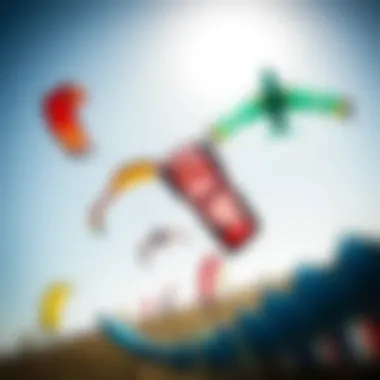
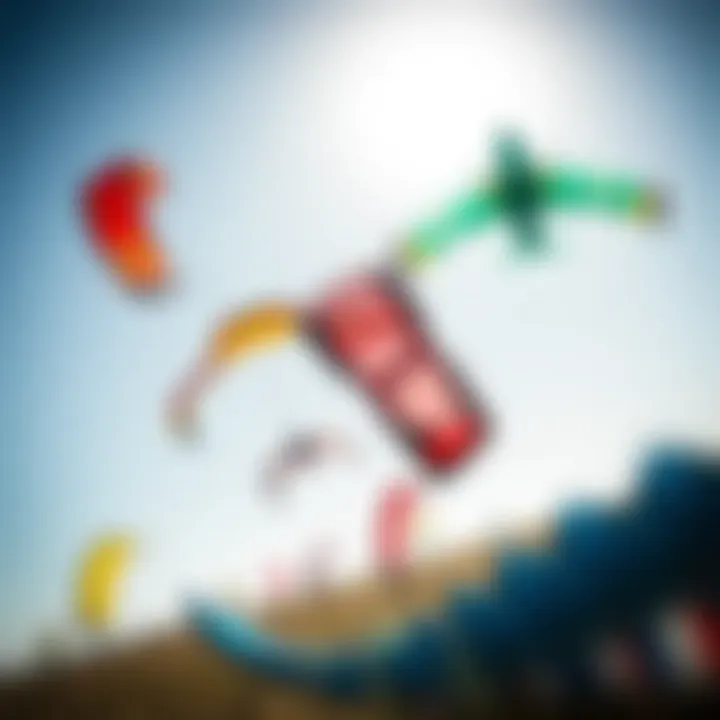
- Advantages:
- Effective in low wind conditions.
- Lightweight and packable.
- Durable with fewer parts to worry about.
However, keep in mind that their performance might drop off in stronger winds unless you're experienced. Novices can struggle due to their sensitivity to changes in wind direction.
Leading Edge Inflatable (LEI) Kites
Often seen as the workhorse of the kiteboarding world, LEI kites are characterized by their inflatable leading edge. These kites are highly versatile and perform well in a variety of conditions.
The open design allows for better steering and control, which is especially useful for jumping and tricks. Also, the inflated leading edge makes them pretty stable in turbulent winds.
- Advantages:
- Robust and reliable across conditions.
- Excellent for jumping and freestyle tricks.
- Comfortable in gusty scenarios.
Nonetheless, their buoyancy requires a little more effort to launch and land compared to other types. It’s generally a good idea for beginners to learn on these kites as they easily forgive beginners’ errors.
Delta Kites
Delta kites feature a unique shape that resembles a triangle. This design is not just for show; it offers increased stability and performance in varied wind conditions. The broad wing area provides a smooth ride, making it a preferred choice for those who enjoy cruising rather than extreme tricks.
- Advantages:
- Superior stability in changing winds.
- Great for beginners due to forgiving nature.
- Efficient at catching wind, allowing for smooth transitions.
However, while delta kites might not be the best choice for high-performance freestyle riding, they suit those who prefer a more laid-back experience on the water.
Hybrid Kites
As the name suggests, hybrid kites combine elements from foil and LEI kites. This blend enables riders to enjoy diverse performance characteristics. They are often considered to strike a balance, providing good lift and maneuverability without sacrificing too much on any front.
- Advantages:
- Adaptable to various riding styles.
- They can perform well in both light and gusty winds.
- Ideal for intermediate riders looking to expand their horizons.
While hybrid kites may not excel in any specific domain, they are often the go-to for those who wish to dabble in different kiteboarding techniques without jumping into specialized gear.
Selecting the right kite can vastly influence not just your skill development but also the enjoyment and overall experience you gain from kite surfing.
Key Factors in Choosing a Kite
When diving headfirst into the intricate world of kite surfing, it quickly becomes apparent that the choice of kite isn’t just a mere task; it’s a pivotal element that can either enhance one's experience or leave one floundering in the water. If you’re pondering over different options available, it is crucial to understand a few key factors that will ultimately steer your decision.
Skill Level Considerations
Your skill level plays a monumental role in determining the kite suitable for you. Beginners should look for kites that offer stability and ease of handling. For instance, Nobile's NHP model, known for its user-friendly design, can be a fantastic choice for novice kite surfers who are just getting their feet wet. On the contrary, experienced riders might lean toward kites that provide greater responsiveness and performance, such as the Slingshot Ghost. The difference is akin to learning to ride a bicycle with training wheels versus aiming for stunt tricks on a BMX. Sitting and chatting with local kite instructors or gleaning insights from community forums like Reddit can further clarify what fits your current abilities.
Weather and Water Conditions
Let's not beat around the bush; factor in the weather and water conditions before investing in any kite. Wind speed, direction, and the nature of the water—whether it's choppy or flat—can significantly impact your experience. A kite that works beautifully on a breezy day may not stand a chance when the winds change direction.
- Cool waters, choppy conditions: Consider a slightly larger kite. It’ll pack more power.
- Calm conditions: A smaller or medium-sized kite might do just fine.
Always check forecasts before heading to the water. There's a wealth of resources like Windy.com that can help gauge wind conditions. If you're riding in unpredictable waters, having a kite that can adapt can be a game changer.
Size and Design Preferences
Kites come in an array of sizes and designs, so understanding these factors is paramount. Generally, a larger kite generates more power and lift, making it perfect for lighter wind days while smaller kites excel in stronger winds. As a professional surfer would tell you, it's all about finding what feels right. Take a moment to reflect on your height and weight. Normal recommendations float around:
- Less than 65 kg: 7-9m kites for decent wind.
- Between 65-85 kg: 9-12m kites should work just fine.
- Over 85 kg: Think about 12-14m kites when the wind isn’t gusting too strong.
Design also comes into play. Are you drawn to sleek minimalist models or colorful, more intricate designs? Each brand brings its flair to the table; check out brands like Cabrinha and Core for cutting-edge features tailored to surf-style riding or freestyle tricks.
Choosing a kite isn’t just picking a color or a brand; it’s about aligning your selection with personal preference, skill level, and the riding conditions you can expect. Stay informed and explore, and you’ll likely end up with a kite that feels tailored just for you.
Where to Buy Kites
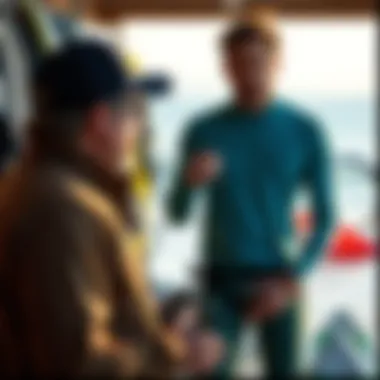
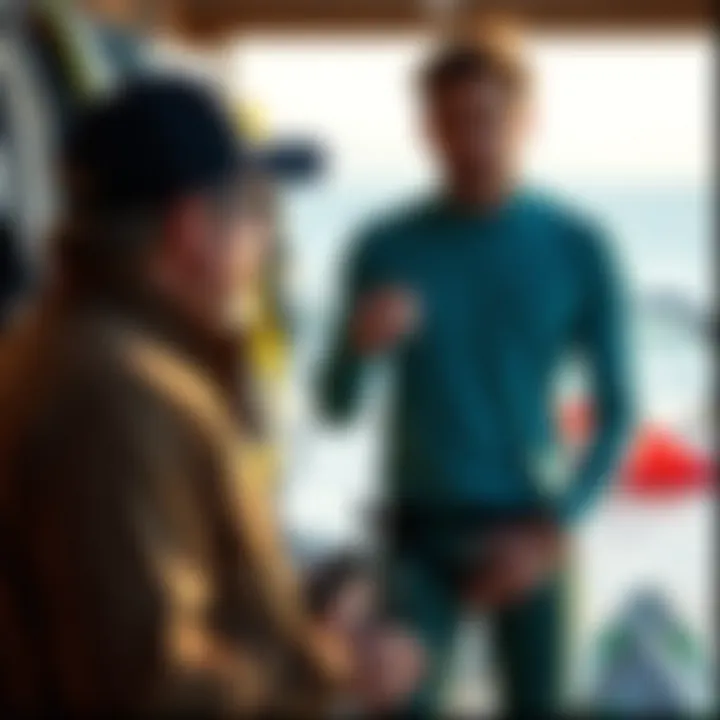
When it comes to purchasing kites for kite surfing, knowing where to buy is just as vital as understanding the kites themselves. The right purchasing venue can greatly impact not only your options but also the value you receive with your purchase. Let's delve into the different avenues available and what you should keep in mind.
Local Shops vs. Online Retailers
There's a tug-of-war between local shops and online retailers when it comes to buying kites. Local shops offer a hands-on experience. You can see the kites up close, perhaps test the flex of a leading edge inflatable or feel the smooth fabric of a foil kite. Experts at these shops can guide you, answering your questions on the spot—this is invaluable, especially for those new to the sport.
However, online retailers open up a whole new world, often boasting a broader selection and competitive pricing. You might stumble upon that obscure delta kite you've been dreaming of or find promotional deals during special sales. The key here is finding a reputable online seller. You want to ensure you can trust their product descriptions and return policies.
So, weighing the benefits:
- Local Shops:
- Online Retailers:
- Personalized expert advice
- Ability to physically inspect the gear
- Support local businesses
- Larger product range
- Often cheaper prices
- Convenience of shopping from home
Evaluating Seller Credibility
No one wants to be left high and dry with a faulty kite after spending a chunk of change, so assessing seller credibility is your next step. Whether you’re browsing brick-and-mortar locations or websites, keep an eye out for certain red flags.
- Check reviews. Look for feedback from previous customers, especially regarding the quality of kites and customer service. Websites like Reddit often have threads discussing experiences with various brands or stores.
- Look for warranties and return policies—good sellers stand by their products and offer reasonable terms.
- Look at their social media presence; active engagement can signal a credible seller.
- Verify their experience in the industry; long-standing sellers generally offer better reliability.
"The best guarantee of a good purchase is a trustworthy seller who values customer satisfaction."
Shopping Offseason
Timing is everything in kite surfing gear purchases, and hitting the offseason can lead to some sweet deals. Most kite sales pick up during peak kite surfing season, which means everyone is clamoring for the latest models. But in the offseason, when the tides are calm and surfers are fewer, you can often find impressive discounts or clearance sales.
Benefits of shopping in the offseason include:
- Prices can drop significantly as stores aim to clear out old inventory.
- Greater likelihood of finding specialized kites that might not have been sold during peak times.
- It grants you the chance to thoroughly research and make well-considered decisions without the pressure of the season.
To prepare for this strategic shopping method, keep an eye on seasonal sales for kite brands and subscribe to newsletters for exclusive offers.
Whether you choose to support local equipment shops, cast your net wide online, assess seller credibility meticulously, or time your purchase just right by shopping offseason, being savvy in where to buy your kite ensures you’re set to ride the wind with confidence.
New vs. Used Kites
When it comes to selecting the right kite for kite surfing, one major decision is whether to go for a new model or a secondhand option. This choice can significantly influence not just your budget but also your overall experience on the water. Both new and used kites come with their unique advantages and drawbacks, making it essential to weigh these factors carefully to make a sound decision.
Advantages of New Kites
Opting for brand new kites means you'd be riding the latest and greatest that the market has to offer.
- State-of-the-Art Technology: New kites often integrate the latest advancements in design and materials. This could mean better durability, improved efficiency, or enhanced performance in various conditions.
- Warranty Protection: Buying a new kite typically comes with some form of warranty from the manufacturer, offering peace of mind should there be any defects or issues.
- Fresh Equipment: New kites haven't been exposed to wear and tear, ensuring you're starting with a clean slate and no hidden weaknesses.
However, it's essential to consider that these benefits often come at a higher cost. New kites can be a hefty investment, especially with premium brands like Naish or Cabrinha.
Reasons to Consider Used Kites
While new kites have their perks, the allure of a secondhand option is hard to overlook, especially for those on a tighter budget.
- Cost-Effectiveness: One of the most significant advantages of used kites is the price. You can often find quality used kites at a fraction of the price of a new one, which can be particularly attractive for beginners or those looking to upgrade without breaking the bank.
- Available Variety: The used market may offer unique, hard-to-find models that are no longer in production. This can be a treasure trove for seasoned kite surfers looking for something different or specific.
- Less Depreciation: Kites depreciate quickly after purchase, so buying used means you're often getting a better resale value down the line if you choose to sell.
Yet, one must tread cautiously in the secondhand market—it is crucial to know what to look for in a used kite.
Assessing Condition and Maintenance
Whether you're eyeing a shiny new kite or an older model, assessing the condition is vital.
- Visual Inspection: Look for any signs of damage such as tears, frayed lines, or delamination on the fabric. Check seams carefully; any weakness here could put a damper on your surf experience.
- Inflation Check: A solid inflatable kite needs to hold air properly. You should inflate it and watch for any slow leaks.
- Bridle and Lines: The bridle setup should be in good shape without any fraying, as this can affect the kite's performance.
Don't forget to ask about the kite's history: how often has it been used? Has it been regularly maintained? Getting a kite's background could provide insight into its reliability.
"Knowledge is power, especially when you're out searching for gear that takes you soaring over the waves."
For more information on kite surfing gear, check out resources like Wikipedia or Reddit.
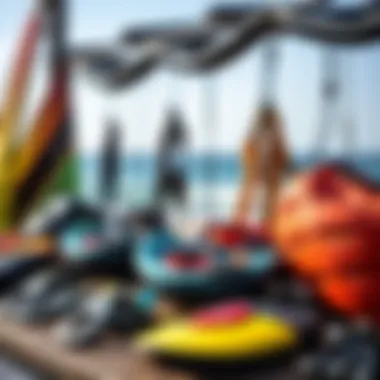
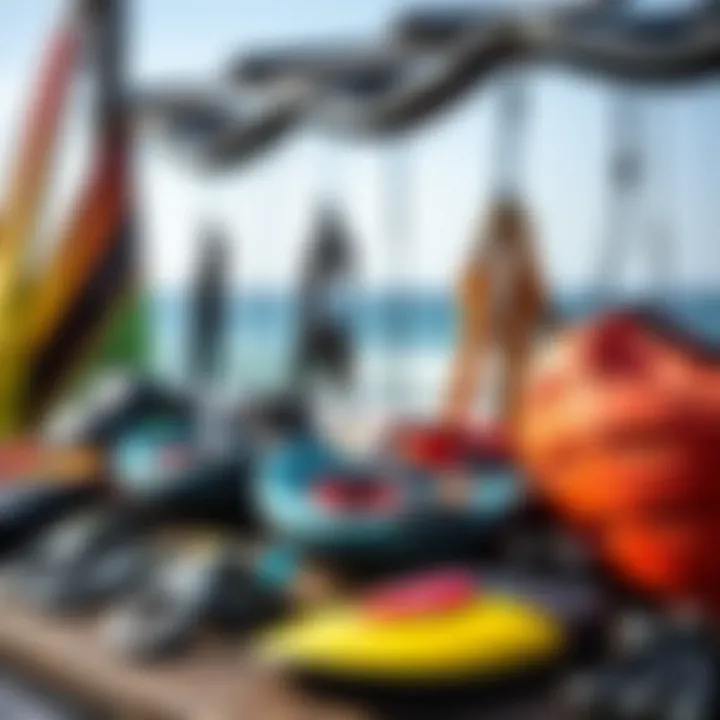
Evaluating Kite Performance and Specifications
Assessing the performance and specifications of kites is a critical part of the buying process for any kite surfer. The kite is not merely a sail attached to a string — it’s an integral component that can significantly affect your overall experience on the water. Understanding how to evaluate these aspects will empower you to make informed choices, crucial for personal safety, performance, and enjoyment.
Understanding Aspect Ratio
The aspect ratio of a kite plays a vital role in its performance characteristics. Essentially, it refers to the ratio of the wingspan to the average height of the kite. A high aspect ratio means the kite is longer and narrower, which generally leads to increased efficiency and speed. These kites tend to slice through the air more smoothly, making them ideal for advanced maneuvers.
On the flip side, kites with a low aspect ratio are typically wider and shorter, providing more stability and lifting power at lower speeds. They excel in more turbulent wind conditions, making them a favorite among beginners or those who prefer to ride in choppy waters. Understanding your riding style and conditions is essential when considering the aspect ratio, whether you prefer fast runs or stable freestyle sessions.
"Choosing the right aspect ratio can transform your experience, giving you the ability to harness the wind more effectively."
Assessing Material Quality
The quality of materials used in kite construction cannot be overlooked. By knowing what to look for, you can identify kites that will stand the test of time, particularly in rugged or variable conditions. When evaluating a kite's material, consider the following:
- Ripstop Nylon vs. Polyester: Ripstop nylon is favored for its lightweight and durability, as it resists tearing and offers excellent performance in various wind conditions. Polyester, while heavier, might offer better stability under certain conditions.
- Leading Edge Construction: The leading edge, crucial for performance, should be reinforced with sturdy materials that can withstand turbulent winds. Kites designed for premium performance often include blends of materials for a more robust structure.
- Seam Quality: Inspecting the seams is also vital. Double-stitched seams often indicate a stronger hold, less risk of ripping, and increased longevity.
Investing in a kite made of high-quality materials may seem steep initially, but it pays dividends in durability and performance.
Innovations in Kite Technology
The kite surfing landscape is constantly evolving, with technology bringing about remarkable advancements in kite designs. New innovations can enhance performance, safety, and the overall experience. Some notable trends include:
- Smart Kites: Some manufacturers are now incorporating technology that allows kites to adjust their shape based on wind conditions, maintaining optimal performance without the need for constant manual adjustments.
- Eco-Friendly Materials: As environmental awareness grows, many brands are focusing on sustainable kite materials that don’t sacrifice performance. These materials are gentler on the oceans and can be just as durable as traditional options.
- Improved Control Systems: Recent advancements in control systems allow for better responsiveness and ease of use. This innovation means less time tangled in lines and more time enjoying the freedom of the water.
Keeping abreast of these technological developments can give you an edge, not just in terms of performance, but also in being a responsible kite surfer.
Maintenance and Care for Kites
Proper maintenance and care of your kite surfing gear is crucial to ensure longevity and enhance the performance of your kites. Just like any other high-performance equipment, kites require attentive care to sustain their structural integrity and efficiency. Ignoring basic maintenance can lead to catastrophic failures on the water and costly replacements. Moreover, well-maintained kites perform better, providing an optimal riding experience and safety on the waves. This section delves into the necessary steps to preserve your kites, highlighting rinse and dry techniques, proper storage practices, and handy repair tips for those inevitable wear and tear moments.
Rinse and Dry Techniques
After each session, rinsing your kite with fresh water is a no-brainer. Saltwater and sand can wreak havoc, corroding materials and compromising the fabric's strength. Use a gentle spray nozzle to avoid harsh blasts that might damage delicate parts. Here’s a simple routine to follow:
- Detach all lines and accessories to prevent tangling.
- Use a soft brush to gently scrub areas with stubborn dirt, paying special attention to seams and connectors.
- Rinse thoroughly with fresh water, ensuring every part gets a wash.
- Hang your kite upside down or laid flat to dry completely. Avoid direct sunlight as it can degrade the material over time.
Storage Practices
Storing your kite correctly is just as important as rinsing it. When improperly stored, kites can develop creases or even mold. Ideally, consider the following:
- Cool, dry spaces are best. Avoid places with high humidity or extreme temperatures to prevent material degradation.
- Roll your kite instead of folding it, which helps maintain the structural integrity of the panels.
- Use protective bags designed for kites to shield them from dust and UV rays. A dedicated bag keeps everything together and reduces wear.
Remember, a little foresight in how you treat your gear can extend its life significantly.
Repair Tips for Common Issues
Even with the best care, kites are subject to inevitable wear and rough handling. However, many common issues can be addressed with simple repairs. Here are a few:
- Small tears in the fabric can be patched using kite repair tape. Make sure to clean the area and allow it to dry before applying the tape for a good seal.
- Leaking bladder? Locate the leak by inflating the kite and listening for hissing. Once found, you can use a bladder repair kit to seal the hole.
- Line fraying can be dangerous. Regularly check your lines and replace any that show signs of wear. Invest in a solid line maintenance routine to avoid surprises.
Taking the time to maintain, store, and repair your kite can not only save you money but also improve your overall kite surfing experience. Remember, a well-cared-for kite not only serves you well on the water; it makes every ride safer and more enjoyable. For those looking to gain additional knowledge on kite maintenance, the Passive Guide on Kite Care (http://kitecareguide.com) provides more in-depth insights and tips.
The Future of Kite Surfing Gear
The evolution of kite surfing gear plays a significant role in shaping the experience of enthusiasts and professionals alike. With constant advancements in technology and growing environmental considerations, the future of this sport seems poised for exciting shifts. Recognizing the implications of these changes can provide valuable insights for anyone keen to invest in kite surfing equipment. As we venture into this segment, we will explore trends in design and technology, and how environmental concerns are influencing kite gear innovations.
Trends in Design and Technology
The design of kite surfing gear is not just about aesthetics; it’s about enhancing performance, safety, and user experience. Over the years, various trends have emerged that have revolutionized the ways kites are constructed and used.
- Materials: New materials such as ultra-lightweight fabrics and stronger rip-stop fabrics help reduce the overall weight of kites while boosting durability and performance. For instance, the introduction of high-tenacity polyester has made kites more resistant to tears and punctures.
- Shape Optimization: Kite shapes continue to evolve, catering to more diverse conditions and rider preferences. Delta and hybrid kites, for example, are becoming more popular due to their versatility and improved safety characteristics.
- Adaptive Control Systems: Technological advancements have led to more sophisticated control systems that adapt to changing wind conditions, offering better handling and stability. These features make it easier for riders to manage their kites, especially in unpredictable weather.
- Smart Kites: Some innovators are developing smart kites that integrate sensors to provide real-time data, enhancing performance analytics and helping riders perfect their skills.
Understanding these trends in design and technology is crucial, not just for performance, but for ensuring riders remain safe while enjoying the sport. The more informed you are about the capabilities and limits of your gear, the better your kite surfing experience will be.
Environmental Considerations
As kite surfing continues to gain traction worldwide, the environmental impact of manufacturing and disposing of equipment has come under scrutiny. Several brands are now prioritizing sustainability in their production processes to reduce their carbon footprint and promote environmental stewardship.
- Sustainable Materials: More companies are investing in sustainable materials like recycled plastics and eco-friendly fabrics for kite construction. This trend supports a circular economy, reducing waste and the use of virgin resources.
- Environmental Awareness Campaigns: Many organizations and brands focus on raising awareness about ocean conservation, encouraging kitesurfers to respect local ecosystems. Engaging in beach clean-ups and promoting educational initiatives can lead to a more conscious community.
- Longevity and Repairability: As awareness grows regarding consumerism's impact, there’s a push for designing kites that last longer and are easier to repair, shifting the narrative away from disposable culture to a more sustainable approach.
"The future of kitesurfing lies not only in its technical advancements but also in how we can responsibly enjoy this exhilarating sport while safeguarding the environment we cherish."
By prioritizing eco-conscious practices, the kite surfing industry can pave the way for a brighter future, harmonizing thrill with environmental responsibility. As both consumers and manufacturers become increasingly aware of these issues, the landscape of kite surfing gear will continue to evolve, emphasizing not just performance, but a sustainable approach to riding the waves.







